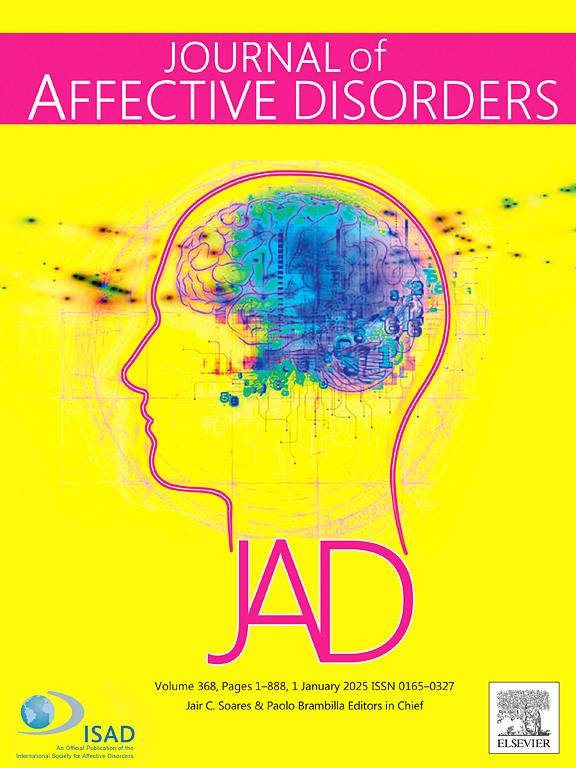使用数字生物标志物预测维持药物治疗缓解抑郁症的症状恶化:一项使用机器学习的预后建模研究。
IF 4.9
2区 医学
Q1 CLINICAL NEUROLOGY
引用次数: 0
摘要
背景:抑郁症是高度复发的,及时预测其复发是至关重要的。我们应用机器学习来预测抑郁症状的恶化。方法:我们使用智能手机应用程序和可穿戴设备对复发性抑郁症患者进行了为期52周的维持药物治疗队列研究。参与者通过每周在应用程序上填写凯斯勒心理困扰量表(K6)来报告他们的抑郁程度。我们首先根据参与者的生活方式特征对他们进行分类。然后,我们应用留一个参与者的交叉验证(LOOCV) XGBoost来预测K6分数。我们还模拟了模型的性能,将新患者的数据收集一段时间,然后添加到现有数据集中,以预测新患者未来的症状恶化。结果:我们分析了89名参与者的数据(49名男性;中位年龄44 岁)。我们确定了两组不同的参与者:第一组的参与者睡眠模式不稳定,花在室内的时间更多,而第二组的参与者花在工作/学习上的时间更多。直观的LOOCV性能表现出良好的AUC和较低的kappa。当我们加入新患者三个月的观察结果时,预测和观察到的K6分类之间的加权kappa在第一类中提高到0.68(95 %置信区间:0.55-0.81),在第二类中提高到0.59(0.48-0.70)。结论:通过行为模式对患者进行分类并应用机器学习,我们可以建立维持药物治疗患者抑郁症复发的预测模型。资助:Shionogi & Co., Ltd本文章由计算机程序翻译,如有差异,请以英文原文为准。
Predicting symptom worsening in remitted depression on maintenance pharmacotherapy using digital biomarkers: A prognostic modeling study using machine learning
Background
Depression is highly recurrent, and predicting relapses in a timely manner is critical. We applied machine learning to predict the worsening of depressive symptoms.
Methods
We conducted a 52-week cohort study of patients with recurrent depression on maintenance pharmacotherapy, using a smartphone app and a wearable device. Participants reported their depression level by filling in the Kessler Psychological Distress Scale (K6) every week on the app. We first classified participants based on their lifestyle characteristics. We then applied the leave-one-participant-out cross-validated (LOOCV) XGBoost to predict K6 scores. We also simulated how the model can perform, where the data of a new patient is collected for some time and then added to the existing dataset to predict the new patient's symptom worsening in the future.
Results
We analyzed the data from 89 participants (49 males; median age, 44 years). We identified two distinct clusters of participants: participants in Cluster 1 had unstable sleep patterns and spent more time indoors, whereas those in Cluster 2 spent more time working/studying. The straightforward LOOCV performance showed good AUC but low kappa. When we added observations of a new patient for three months, the weighted kappa between the predicted and the observed K6 classes improved to 0.68 (95 % confidence interval: 0.55–0.81) for Cluster 1 and 0.59 (0.48–0.70) for Cluster 2.
Conclusions
Subtyping patients by their behavioral patterns and applying machine learning allowed us to build prediction models for depression relapses among patients on maintenance pharmacotherapy.
Funding
Shionogi & Co., Ltd.
求助全文
通过发布文献求助,成功后即可免费获取论文全文。
去求助
来源期刊

Journal of affective disorders
医学-精神病学
CiteScore
10.90
自引率
6.10%
发文量
1319
审稿时长
9.3 weeks
期刊介绍:
The Journal of Affective Disorders publishes papers concerned with affective disorders in the widest sense: depression, mania, mood spectrum, emotions and personality, anxiety and stress. It is interdisciplinary and aims to bring together different approaches for a diverse readership. Top quality papers will be accepted dealing with any aspect of affective disorders, including neuroimaging, cognitive neurosciences, genetics, molecular biology, experimental and clinical neurosciences, pharmacology, neuroimmunoendocrinology, intervention and treatment trials.
 求助内容:
求助内容: 应助结果提醒方式:
应助结果提醒方式:


